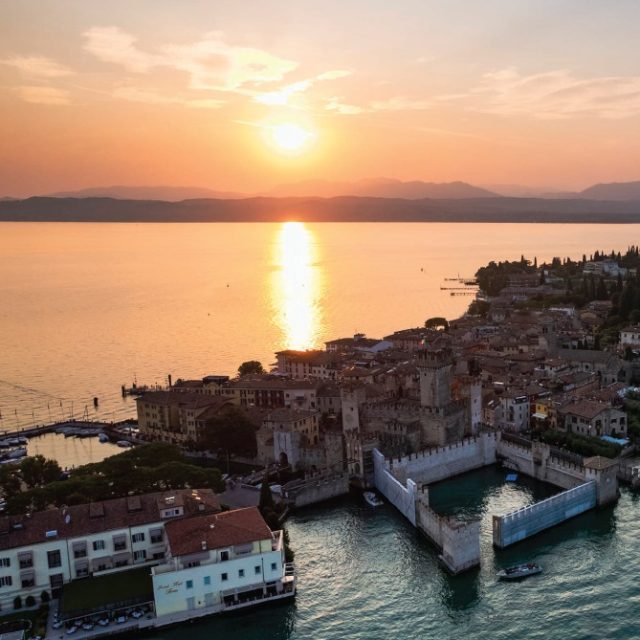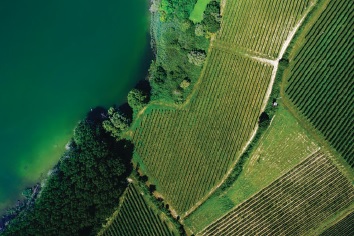This website uses cookies so that we can provide you with the best user experience possible. Cookie information is stored in your browser and performs functions such as recognising you when you return to our website and helping our team to understand which sections of the website you find most interesting and useful.
Lugana DOC – A grape of many talents
Approaching a new audience is not an easy job for a DOC that spans just 2,500 hectares, but Lugana, in northern Italy, is making itself known on the global stage, with the help of a grape variety that boasts real versatility.

Bordered by Sirmione and Pozzolengo to the north and south, and Desenzano del Garda, Peschiera del Garda and Lonato del Garda to the east and west, the denomination of Lugana straddles the Lombardy and Veneto winemaking regions.
The viticultural heritage of the area can be traced to the Roman Empire. In more recent history, in 1967 Lugana was the first Lombardian wine, and one of the first in Italy, to earn a DOC, recognising the historical tie between the Turbiana white grape planted here and its region of origin.
The consortium is keen to expand the recognition of its wines, both domestically and on a global scale. Lugana is well on its way to reaching its goal of international acclaim. Its wines are now more successful abroad than in the domestic market, with exports accounting for about 70% of the bottles produced. Germany is responsible for the majority of these exports, but the DOC has a wish list of other markets, both neighbouring and further afield, with which to slowly broaden its horizons.
Switzerland, the UK, the US, and Japan – already lovers of Italian wines – top this wish list. But the promotion of Lugana wines must proceed on two fronts, towards an international audience as well as domestic regions outside of those adjacent to production that lack knowledge of Lugana wines.
Italy is known for its many winemaking regions and native grape varieties, which can make it challenging for producers to distinguish themselves, and getting noticed in this ocean of varieties, typologies, and wines can be difficult. But the consortium, which brings together about 90% of Lugana’s producers, divided between bottlers and winemakers, is making progress. The number of bottles produced in 2021 was more than 27 million, a 12% hike on figures from 2020.
One thing that differentiates the region and its wines is its versatility. Grown on the southern shores of Lake Garda, the unique native grape variety Turbiana is at the centre of this small growing region. Although production standards allow for the presence of complimentary nonaromatic white grape varieties at a 10% ratio, today winemakers in the area tend to make Lugana wines only, and exclusively with Turbiana grapes.
FIVE STYLES
Turbiana is vinified in five styles, which give refined white wines with great personality, structure and longevity. The five types of Lugana wine include: the “Classic” version, the Spumante version
(produced using either the traditional or Charmat method), the Superiore version, the Riserva and the Vendemmia Tardiva (late harvest), all with a single and very versatile grape.
- Lugana Classico wines account for about 90% of the DOC’s total production, standing tall as the driving force behind the entire appellation. This wine style acts as the region’s quality-control gauge. Its colour is a light straw-yellow with hints of green; its aroma is a delicate mix of floral and almond notes.
- Lugana Superiore was officially introduced in 1998, and in order to bear this label the wine must be aged or matured for at least one year after the grapes have been harvested. Its profile is more variegated and complex: the colour has more golden hues, with more articulated aromas, hints of wild herbs, chlorophyll, ripe apple and citrus, mixed with notes of nuts or spices from the wood used in the ageing process.
- The Lugana Riserva, introduced as part of Lugana’s most recent revision of production standards in 2011, is the natural evolution of the Superiore. It must age or mature for at least 24 months, six of which are required to be in bottle. The Riserva differs from the Superiore: it has brighter colours, more evolved and complex aromas, with smoky and balsamic notes, and warmer, more mineral flavours.
- Then comes Vendemmia Tardiva; a remarkably different, more experimental type of Lugana, which lacks the sweet viscosity of a traditional passito. Lugana of this type is made with “over-ripened” grapes that have been allowed to remain on the vine instead of being harvested, then stored until suitably dry like other typical styles of Italian late-harvest wines. In this way, the wine’s style is more akin to a late-harvest expression from Germany or Alsace, with rich, concentrated flavours and acidity to balance its sweetness.
- Finally, the last of Lugana’s many faces is its Spumante, introduced in 1975 and deemed “one of the best surprises of the DOC” by its makers.
The longevity of Lugana’s dry and still versions vary from type to type, but winemakers are becoming increasingly oriented towards creating more complex, ageworthy expressions. Vinification in steel vats and on lees are being more regularly undertaken to enhance both body and flavour, as well as mixed ageing techniques (partly in steel, partly in wood) for top selections. The more youthful expressions can also safely remain in the cellar for two to three years, while the Superiore and Riserva selections can be expected to fulfil their evolutionary potential after a full decade.
The potential of ageing and the use of fine lees help to strengthen the identity of the DOC towards a common goal: the quality of Lugana, the Turbiana grape, and unity among the Lugana producers in pursuing the best quality for its wines.
GASTRONOMIC VERSATILITY
Winemakers are also passionate about showing Lugana’s gastronomic capabilities. Like all Italian wines with century-long traditions linking them to their place of origin, Lugana is paired with the classic gastronomic repertoire of the region. This includes dishes centred around freshwater fish from the nearby lake, river or stream, as well as sea fish.
The Classico can be readily paired with seafood antipasti, while the Superiore and Riserva are the perfect partner for richer and more complex fish dishes and several white meat dishes, such as chicken, cockrel and rabbit roasted in the oven.
The Vendemmia Tardiva wines are ideally matched with cheeses, from the fresher varieties such as ricotta and robiola, to more seasoned and flavoursome cheeses like Grana Padano and Provolone Valpadana.
Spumante has a broad range of possible pairings, meaning the sparkling wine can be served right throughout the meal. Travelling through the beautiful tourist location in Northern Italy – on roads lined with olive groves, vineyards, wineries, farmhouses, and country homes, one would never guess that the wines of that region pair perfectly with typical Japanese dishes such as sushi or tempura, but the consortium is confident that they do.
Thus, its versatility, in both ageing potential and pairing, is what makes the Turbiana grape and its native home so special.

LUGANA 2022 VINTAGE
The Lugana microclimate, which benefits from the temperate breezes of Lake Garda, is mild, and seldom subject to sharp changes in temperature between night and day. Fabio Zenato, president of the consortium, spoke to db about the most recent harvest in the Lugana DOC, and had a positive outlook on how the 2022 vintage is set to shape up. “When we tackle the 2022 harvest
issue, we cannot fail to take into consideration first the fact that we are facing an exceptional season, with very modest rainfall in the past 12 months, compared with the average of the last 25 years,” he says. Spraying was drastically reduced as a result of such a dry season, as the lack of rainfall meant little disease risk for the vines. “For Lugana it was an overall positive season,” says Zenato, with grapes showing good varietal expression and yields that equal the yearly average.
“The hot vintage could lead to a presence in the wine of more pronounced fruity notes,” he says. The denomination in general has suffered little from the droughts which plagued much of Europe during the 2022 harvest. The majority of the producers in the region have implemented drip-irrigation systems over the past 15 years in response to climate change, and the nearby lake provides a moderating influence on Lugana’s vineyards.
He adds: “From a quantitative point of view, we expect a good yield overall in a uniform way, given the season was without adverse weather phenomena such as hail, with a possible decrease in the grape and wine yield in the pressing phase, attributable to the long period of slowed-down activity of the vine in the months of July and August due to the persistence of the drought.”
![]()

